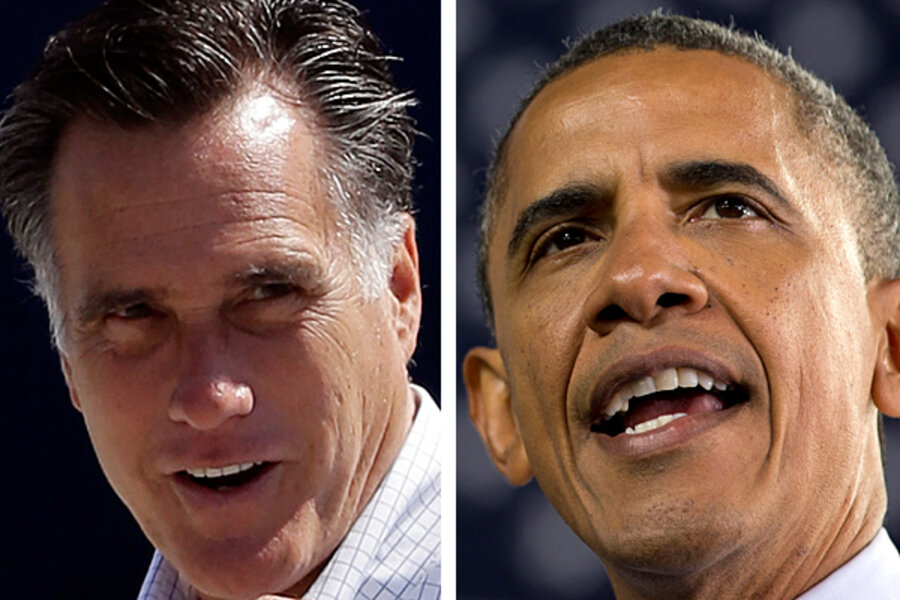Why Obama, Romney gravitate to '60 Minutes' and 'The View'
Loading...
It wasn't that long ago that candidate Bill Clinton's appearance on "The Arsenio Hall Show" set pundits' tongues to wagging. Stepping outside the confines of press conferences and serious news programs was considered risky, possibly trivializing the aspirant to the office of the presidency. Suffice it to say that such qualms, if any had lingered, have been definitively laid to rest during the 2012 election, a campaign during which President Obama and GOP rival Mitt Romney have tapped such "free media" – of both the hard and soft varieties – at unprecedented levels.
The most recent exhibit came Sunday night, when "60 Minutes," the long-running CBS news show, aired back-to-back interviews with Mr. Obama and Mr. Romney. Next, both the president and first lady Michelle Obama will show up on the daytime talk show “The View” on Tuesday.
Romney, meanwhile, has promised to sit on the sofas of the “sharp-tongued” women, as he dubbed them, in October. And, of course, appearances with the late-night denizens, David Letterman and Jay Leno, continue, with both the candidates and their wives showing up there with regularity. Mrs. Obama read Mr. Letterman’s Top Ten List heading into the Democratic National Convention. Romney has been on "The Tonight Show with Jay Leno" four times, and his wife, Ann, is set to chat with Mr. Leno Tuesday night.
What gives? It's not as if the campaigns, which are rolling in dough, can't afford to buy airtime. Some two-thirds of a billion dollars have already been spent on TV ads, according to the National Journal.
No, such media appearances serve the interests of today's candidates in many ways – and can actually build audience trust amid a climate in which, according to a new Gallup poll, 60 percent of Americans don't trust media coverage in general.
“People tend to trust the media they choose,” whether it’s blogs or social media or a favorite daytime talk show, says Barbara O’Connor, director emeritus of the Institute for Study of Politics and Media at California State University, Sacramento. By appearing on someone's favorite show, a candidate helps to bridge that trust gap, she says.
Bill Rosenberg, a political science professor at Drexel University in Philadelphia, agrees: "The question is not so much resources, which there seems to be plenty of now, but source credibility." Increasingly, people turn to the media outlets they personally trust, so the candidates try to use those avenues to deliver that credibility to those audiences, he adds.
With today's media proliferation, candidates feel a greater burden than ever to cover all the outlets that prospective voters might tap.
There are a lot more of them now than when John Kennedy appeared on "The Tonight Show" during his 1960 presidential campaign. Savvy candidates have long understood how entertainment programs can humanize them and help them reach an audience that may not be tuned into politics, notes Villanova University political scientist Matthew Kerbel, author of “Netroots: Online Progressives and the Transformation of American Politics.” With the advent of social media, he adds via e-mail, “this strategy has evolved to include a presence for candidates on Twitter, Facebook, YouTube and around the political blogosphere, enabling them to reach targeted populations and craft a message on their own terms.”
Then there's also the softball factor.
The president’s campaign seems to like free media because "it’s friendlier" than traditional news interviews, says Ben Bogardus, assistant professor of journalism at Quinnipiac University in Hamden, Conn. “ 'The View,' 'David Letterman,' 'Entertainment Tonight' and other entertainment programs generally ask softball questions, and let the president show off his personality, which is his strength," he adds via e-mail.
While president, Obama has also done many interviews with local TV stations from swing states, notes Professor Bogardus. By inviting the local reporters to the White House, the president gives the home stations something to promote and talk about “for days.” This also leads to positive coverage because the stations don’t use the time to criticize the president, he adds. In a way, he notes, the stations are “star-struck by the opportunity they rarely get.”
For Romney, free media coverage marks a change from the stock and trade of the campaign trail: the 30-second ad spot or the 10-second news clip of his stump speech. Appearances on "60 Minutes" or daytime talk shows also can allow him to push a particular message, says Bogardus. Those interviews also boost the chance that he’ll get a sound bite on the air, he adds, because reporters bored by the standard speech would be attracted to the “new sound.”
It helps voters to see the candidates interviewed by a serious journalist like Steve Kroft on "60 Minutes," says Jeff McCall, a communication professor at DePauw University in Greencastle, Ind, in an e-mail. “[i]t hurts voters, however, when candidates are on soft venues like 'Letterman.' "
"The candidates like those shows because they can act all personable and chat up pop culture topics with interviewers who won't challenge them," he says. "This hurts voters because it gives a false sense of what is important on the political agenda.”





